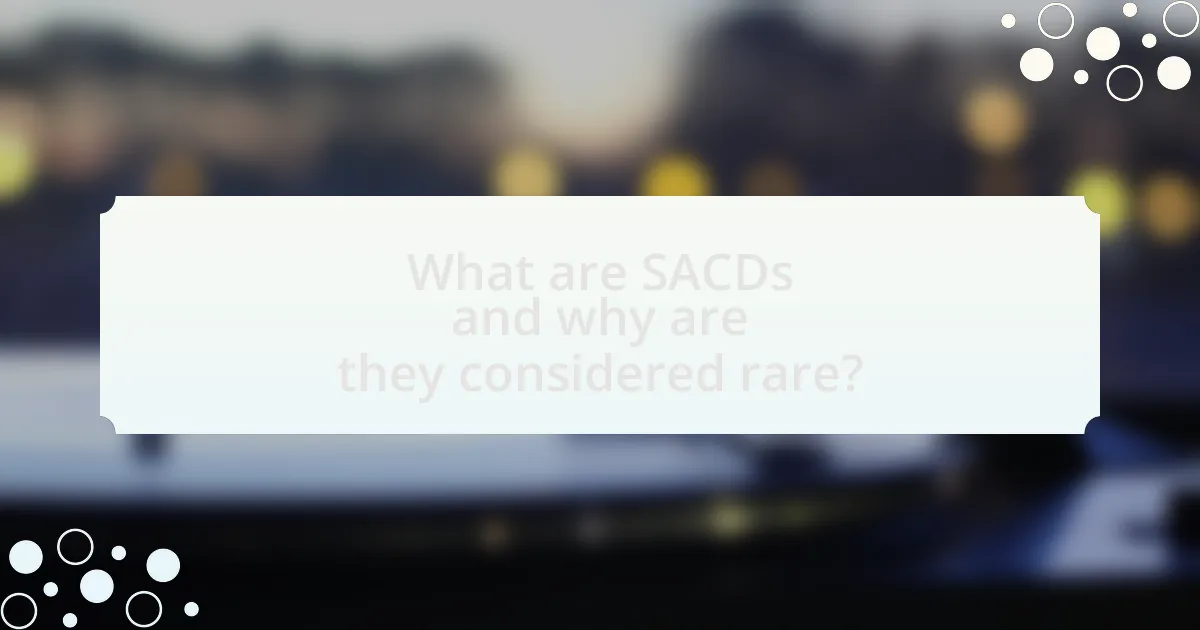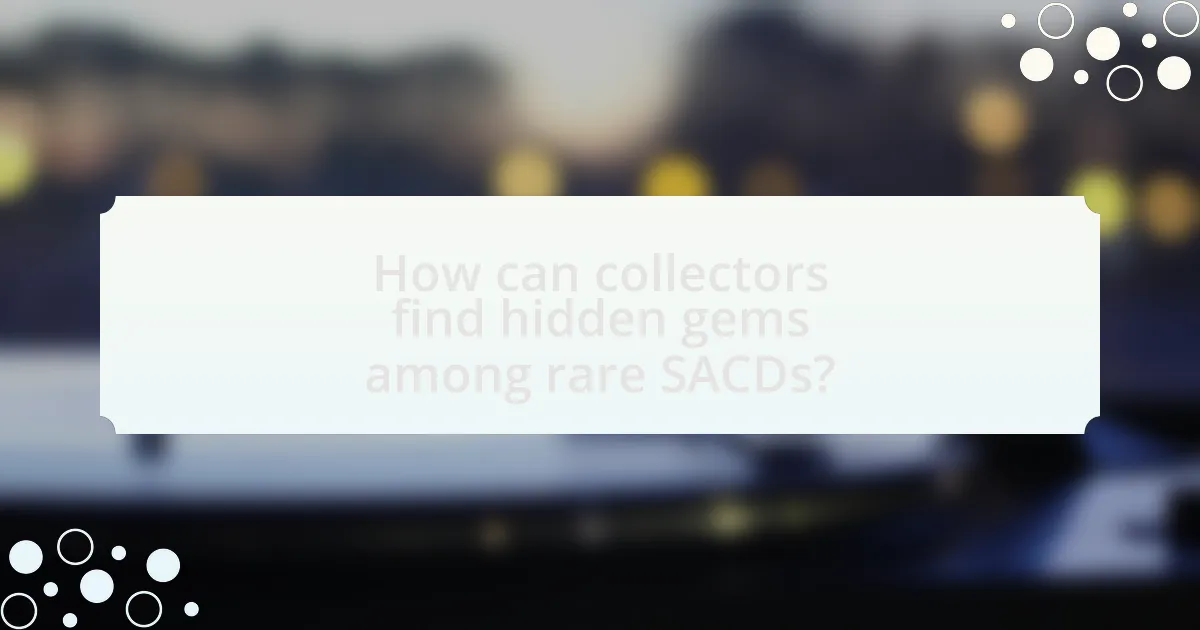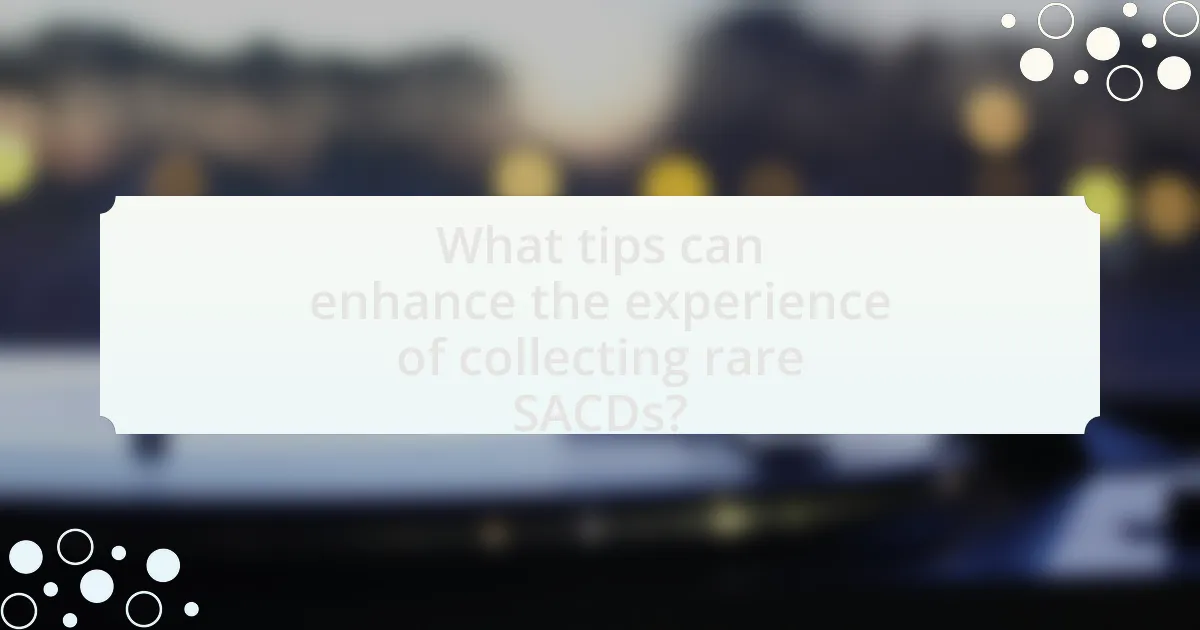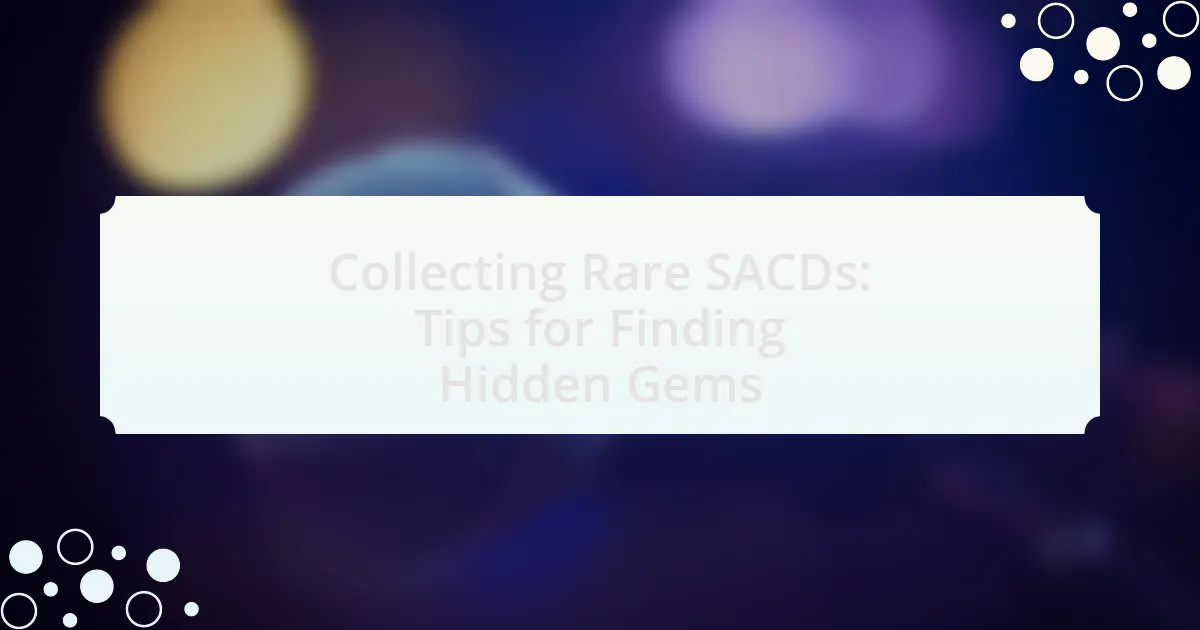The article focuses on collecting rare Super Audio CDs (SACDs), highlighting their unique features, limited production, and the factors contributing to their rarity. It explains how SACDs differ from standard audio formats, emphasizing their superior sound quality and hybrid disc structure. The article also outlines strategies for collectors to identify valuable SACDs, including researching niche labels, attending record fairs, and utilizing online marketplaces. Additionally, it provides tips on maintaining a SACD collection, avoiding common pitfalls, and networking with other collectors to enhance the collecting experience.
What are SACDs and why are they considered rare?

SACDs, or Super Audio CDs, are high-resolution audio discs designed to provide superior sound quality compared to standard CDs. They are considered rare primarily due to their limited production and niche market appeal, as well as the decline in physical media consumption. Since their introduction in 1999, SACDs have not gained widespread adoption, leading to fewer titles being released and a smaller collector base. This scarcity, combined with the audiophile community’s interest in high-fidelity sound, contributes to their rarity and collectible status.
How do SACDs differ from other audio formats?
SACDs, or Super Audio CDs, differ from other audio formats primarily in their ability to deliver higher audio quality through a multi-channel and high-resolution sound experience. Unlike standard CDs, which typically offer 16-bit/44.1 kHz audio, SACDs utilize a 1-bit DSD (Direct Stream Digital) encoding at 2.8224 MHz, allowing for a more detailed and dynamic sound reproduction. This format supports both stereo and multi-channel audio, enhancing the listening experience compared to formats like MP3 or standard CDs, which are limited in their audio fidelity and spatial sound capabilities. The SACD format was developed by Sony and Philips and was introduced in 1999, aiming to provide audiophiles with superior sound quality that traditional formats could not match.
What technical features make SACDs unique?
SACDs, or Super Audio CDs, are unique due to their hybrid disc structure, which allows them to contain both high-resolution audio and standard CD audio formats. This dual-layer design enables playback on both SACD players and standard CD players, providing versatility. Additionally, SACDs utilize Direct Stream Digital (DSD) encoding, which captures audio at a higher sampling rate than traditional CDs, resulting in superior sound quality. The DSD format operates at 2.8224 MHz, significantly exceeding the 44.1 kHz of standard CDs, allowing for a more accurate representation of the original sound. These technical features contribute to the enhanced audio experience that SACDs offer, distinguishing them from regular CDs.
Why is the production of SACDs limited?
The production of SACDs is limited primarily due to the high manufacturing costs and niche market demand. SACDs require specialized equipment and materials for production, which increases expenses compared to standard CDs. Additionally, the audience for SACDs is relatively small, as many consumers prefer digital formats or standard CDs, leading to fewer titles being produced. This limited production is further compounded by the decline in physical media sales overall, as streaming services dominate the market.
What factors contribute to the rarity of SACDs?
The rarity of SACDs is primarily due to limited production runs and a decline in consumer interest. SACDs, or Super Audio CDs, were introduced in the early 2000s but never gained widespread popularity, leading to fewer titles being produced. According to industry reports, many major labels shifted focus to digital formats, further reducing the number of SACD releases. Additionally, the high manufacturing costs associated with SACD technology deterred labels from producing large quantities, resulting in a smaller market and fewer available copies for collectors.
How does the artist or label influence SACD rarity?
The artist or label significantly influences SACD rarity through their popularity, production choices, and marketing strategies. High-profile artists or labels often produce limited editions or special releases, which can lead to increased demand and scarcity. For instance, when a renowned artist like Pink Floyd releases an SACD, the limited nature of the production can create a collectible item, driving up its rarity. Additionally, labels that focus on niche genres or specific audiophile markets may produce fewer copies, further enhancing the rarity of those SACDs. Historical data shows that SACDs from major artists or labels tend to be more sought after, as evidenced by auction prices and collector interest, confirming the correlation between artist/label prominence and SACD rarity.
What role does the edition or release date play in rarity?
The edition or release date significantly influences the rarity of SACDs. Limited editions or early release dates often result in fewer copies being produced, which increases their scarcity in the market. For example, SACDs released during a specific promotional period or as part of a limited run are typically sought after by collectors, leading to higher demand and value. Historical data shows that certain early pressings of popular albums can fetch prices several times higher than later editions due to their limited availability and collector interest.
Why should collectors be interested in rare SACDs?
Collectors should be interested in rare SACDs because they offer superior audio quality and unique content that is often unavailable in other formats. The Super Audio CD format provides high-resolution sound, which enhances the listening experience, making it particularly appealing to audiophiles. Additionally, many rare SACDs feature exclusive tracks, remastered versions, or limited editions that can significantly increase their value over time. For instance, certain titles have been known to appreciate in value by over 300% in the collector’s market, highlighting their investment potential.
What value do rare SACDs hold for audiophiles?
Rare SACDs hold significant value for audiophiles due to their superior sound quality and limited availability. The Super Audio CD format offers higher resolution audio compared to standard CDs, providing a more immersive listening experience. Additionally, rare SACDs often feature exclusive content, such as remastered tracks or unique packaging, which enhances their desirability among collectors. The scarcity of these discs can drive up their market value, making them sought-after items in the audiophile community.
How can rare SACDs appreciate in value over time?
Rare SACDs can appreciate in value over time due to factors such as limited production runs, collector demand, and the quality of the recordings. Limited production runs create scarcity, which often drives up prices as collectors seek to own unique items. Additionally, as music formats evolve, certain SACDs may become nostalgic or sought after, further increasing their desirability. The quality of the recordings, particularly if they feature exclusive content or superior sound quality, can also enhance their value. Historical examples include specific titles that have seen significant price increases in secondary markets, reflecting these dynamics.
How can collectors find hidden gems among rare SACDs?

Collectors can find hidden gems among rare SACDs by researching niche labels and limited editions, as these often produce unique and lesser-known titles. Engaging with online forums and communities dedicated to SACD collecting can provide insights into valuable releases that may not be widely advertised. Additionally, attending record fairs and specialized music shops increases the chances of discovering rare SACDs, as these venues often carry stock that is not available through mainstream retailers. Historical data indicates that many collectors have successfully unearthed sought-after titles by networking with other enthusiasts and sharing information about recent finds.
What are the best places to search for rare SACDs?
The best places to search for rare SACDs include specialized online marketplaces, dedicated music forums, and local record stores. Online platforms like Discogs and eBay offer extensive listings of rare SACDs, often with detailed seller ratings and reviews, ensuring a reliable purchasing experience. Music forums such as AudioKarma and Steve Hoffman Forums provide community insights and trading opportunities among collectors, enhancing the chances of finding elusive titles. Additionally, local record stores, particularly those with a focus on audiophile products, may carry rare SACDs or can assist in special orders, making them valuable resources for collectors.
How do online marketplaces compare to physical stores?
Online marketplaces offer a broader selection and convenience compared to physical stores. While physical stores provide immediate access to products and the ability to inspect items in person, online marketplaces allow collectors to access rare SACDs from various sellers worldwide, often at competitive prices. According to a 2021 report by Statista, e-commerce sales reached $4.28 trillion globally, highlighting the growing preference for online shopping. Additionally, online platforms often feature user reviews and ratings, which can assist collectors in making informed purchasing decisions.
What role do record fairs and conventions play in finding SACDs?
Record fairs and conventions serve as vital venues for discovering SACDs, offering collectors direct access to a diverse range of sellers and rare titles. These events often feature vendors specializing in high-fidelity audio formats, including SACDs, which may not be readily available in mainstream retail outlets. Additionally, the communal atmosphere allows collectors to network, share knowledge, and uncover hidden gems through personal interactions and recommendations. The concentration of niche sellers at these gatherings increases the likelihood of finding unique and hard-to-find SACD releases, making them essential for serious collectors.
What strategies can collectors use to identify valuable SACDs?
Collectors can identify valuable SACDs by researching the artist’s discography, checking for limited editions, and examining the condition of the disc and packaging. Understanding the market demand for specific titles, such as those from renowned labels like Mobile Fidelity Sound Lab, can also enhance the identification process. Additionally, utilizing online marketplaces and forums dedicated to SACD collecting can provide insights into current trends and pricing, helping collectors make informed decisions.
How can collectors research the history of specific SACDs?
Collectors can research the history of specific SACDs by utilizing online databases, collector forums, and music industry resources. Websites like Discogs provide detailed information on releases, including release dates, label information, and mastering details, which are crucial for understanding the history of a specific SACD. Additionally, collector forums and communities often share insights and personal experiences related to particular SACDs, enhancing the knowledge base. Music industry publications and archives can also offer historical context and information about the artists and recordings associated with the SACDs, further aiding collectors in their research.
What tools and resources are available for SACD collectors?
SACD collectors have access to various tools and resources that enhance their collecting experience. Online marketplaces such as Discogs and eBay provide extensive listings of SACDs, allowing collectors to buy, sell, and trade rare titles. Additionally, dedicated forums and communities, like the Steve Hoffman Music Forums, offer valuable insights, recommendations, and discussions among enthusiasts. Collectors can also utilize price tracking websites to monitor market trends and values of specific SACD titles. Furthermore, specialized retailers and record stores often carry a selection of SACDs, providing opportunities for in-person discovery. These resources collectively support SACD collectors in finding and acquiring rare gems in their collections.
What tips can enhance the experience of collecting rare SACDs?

To enhance the experience of collecting rare SACDs, collectors should focus on building a comprehensive knowledge base about the format and its history. Understanding the unique qualities of SACDs, such as their superior audio quality and hybrid nature, allows collectors to appreciate the value of specific titles. Additionally, joining online forums and communities dedicated to SACD collecting can provide insights into rare finds and market trends. Engaging with fellow collectors can lead to valuable tips on where to find hidden gems, as well as information on upcoming releases and reissues. Regularly visiting record stores, estate sales, and online marketplaces increases the chances of discovering rare SACDs, as many collectors may overlook these venues. Keeping an organized catalog of owned titles and wish lists can also streamline the collecting process and help avoid duplicate purchases.
How can collectors build a valuable SACD collection?
Collectors can build a valuable SACD collection by focusing on acquiring limited edition releases, high-demand titles, and critically acclaimed albums. Limited edition SACDs often appreciate in value due to their scarcity, while high-demand titles, such as classic rock or jazz albums, attract collectors’ interest. Additionally, critically acclaimed albums, especially those recognized by awards or high ratings from reputable sources, tend to maintain or increase their value over time. Collectors should also consider the condition of the discs and packaging, as well-preserved items command higher prices in the market.
What criteria should be considered when selecting SACDs for a collection?
When selecting SACDs for a collection, consider the audio quality, genre diversity, artist reputation, and availability of exclusive content. Audio quality is paramount, as SACDs are designed to provide superior sound through high-resolution formats. Genre diversity ensures a well-rounded collection that appeals to various musical tastes. The reputation of the artist can indicate the potential value and enjoyment of the SACD, while exclusive content, such as bonus tracks or unique mixes, can enhance the appeal and rarity of the disc. Collectors often seek out limited editions or special releases, which can also influence the selection criteria.
How can collectors maintain and care for their SACD collection?
Collectors can maintain and care for their SACD collection by storing the discs in a cool, dry environment, away from direct sunlight and extreme temperatures. Proper storage prevents warping and degradation of the discs, which can affect sound quality. Additionally, collectors should handle SACDs by the edges to avoid fingerprints and smudges on the surface, as these can interfere with playback. Regularly cleaning the discs with a soft, lint-free cloth can also help maintain their condition. Using protective cases or sleeves further safeguards the discs from dust and scratches, ensuring longevity and optimal performance.
What common pitfalls should collectors avoid?
Collectors should avoid overpaying for items, as inflated prices can lead to significant financial loss. Many collectors fall into the trap of emotional buying, where the desire to own a specific item overshadows its actual market value. Additionally, neglecting to research the authenticity and condition of rare SACDs can result in purchasing counterfeit or damaged products, which diminishes their value. Furthermore, failing to network with other collectors can limit access to valuable information and opportunities, as the collecting community often shares insights on market trends and hidden gems. Lastly, ignoring proper storage and care for SACDs can lead to deterioration, ultimately affecting their worth.
How can collectors spot counterfeit SACDs?
Collectors can spot counterfeit SACDs by examining the packaging, disc quality, and identifying specific markings. Authentic SACDs typically feature high-quality printing on the cover art, with sharp images and vibrant colors, while counterfeits often have blurry or faded graphics. Additionally, genuine SACDs have a distinct reflective surface and a specific weight; counterfeits may feel lighter or have a less polished finish. Collectors should also look for the presence of a serial number or catalog number on the disc and packaging, as authentic releases usually include these identifiers. Furthermore, checking for the presence of a DSD logo can help, as legitimate SACDs are produced using Direct Stream Digital technology.
What mistakes do new collectors often make?
New collectors often make the mistake of not researching the market value of SACDs before purchasing. This lack of knowledge can lead to overpaying for items that are not as rare or valuable as they believe. For instance, many collectors may assume that all limited editions are worth a premium, but some may have been produced in larger quantities than anticipated, diminishing their value. Additionally, new collectors frequently overlook the importance of condition, failing to assess whether the disc and packaging are in mint condition, which significantly affects resale value.
What are the best practices for networking with other collectors?
The best practices for networking with other collectors include actively participating in collector communities, attending trade shows and conventions, and utilizing social media platforms. Engaging in online forums and groups dedicated to SACD collecting allows collectors to share insights, trade items, and build relationships. Attending events like the Audio Engineering Society conventions provides opportunities to meet fellow enthusiasts and industry experts. Social media platforms, such as Facebook and Instagram, enable collectors to showcase their collections, connect with others, and stay updated on market trends. These practices foster a supportive network that enhances the collecting experience and facilitates access to rare items.
How can online forums and communities assist in SACD collecting?
Online forums and communities significantly assist in SACD collecting by providing platforms for collectors to share information, trade items, and discuss rare finds. These online spaces facilitate connections among enthusiasts, enabling them to exchange tips on where to find specific SACDs, share insights on the value of certain titles, and alert each other to sales or auctions. Additionally, many forums feature dedicated sections for buying, selling, or trading SACDs, which can lead to discovering hidden gems that may not be available through traditional retail channels. The collaborative nature of these communities fosters a wealth of knowledge, as experienced collectors often share their expertise, helping newcomers navigate the complexities of SACD collecting.
What benefits come from attending collector meetups and events?
Attending collector meetups and events provides valuable networking opportunities, access to rare items, and insights into market trends. These gatherings allow collectors to connect with like-minded individuals, fostering relationships that can lead to future trades or sales. Additionally, events often feature vendors and fellow collectors showcasing unique items, which can enhance a collector’s personal collection. Insights shared during discussions can inform collectors about current market values and emerging trends, helping them make informed purchasing decisions.

Leave a Reply